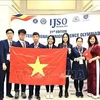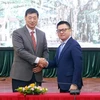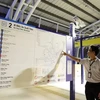 5-star trains are a combined product of four mechanical industries, including railway, aviation, shipping and auto (Photo: Vietnamplus)
5-star trains are a combined product of four mechanical industries, including railway, aviation, shipping and auto (Photo: Vietnamplus) Hanoi (VNA) - The Vietnam Railways Corporation (VNR) has recently built a strategy for the development of railway industry by 2030 and a vision until 2045, in which the orientation of policies focus on developing new industrial products; increasing industrial proportion, localization rate and investing in construction of modern railway industry facilities.
Increasing the localization of new locomotives and wagons
To develop the locomotive industry, VNR will renovate and build locomotive and rail wagon manufacturing units with high localization rates.
The railway industry studies and develops the types of wagons serving urban railways and wagons on the national railway with the train speed of over 100km/hour (currently the highest is 80km/hour), with the localization rate being expected to reach 40-60%; continues to improve locomotive assembly technology with localization rate of 25-30% and proceeds to actively produce locomotives.
The VNR also promotes domestic production of spare parts and railway materials (rails, sleepers, accessories, items, power supply systems for traction, information, signals ...) to meet maintenance needs, looking forward export.
The railway industry takes into account the concentrated investment for industrial establishments specializing in overhaul and assembly of locomotives and spare part production, in which, VNR will perfect its technology investment for companies such as the Gia Lam and Di An Railway joint stock companies to turn them into two modern industrial centers for management and production in the direction of manufacturing and assembling wagons, producing spare parts with high localization rates.
By 2045, the railway industry is determined to invest and innovate technologies to produce industrial products for the electrification of railway and high-speed rail; striving for the railway industry to become a high-tech industry with modern machinery and equipment, attracting high-level scientific and technological personnel
Barriers of capital and policy need to be removed
In order achieve the target, VNR has proposed state management agencies to continue to invest in key mechanical program in railway mechanical development (according to Decision No. 10/2009 / QD-TTg dated January 16, 2009 by the Government but expired at the end of 2015).
Specifically, the Government has a mechanism to support production development, key mechanical products that are new locomotive manufacturing projects which are in the policy of using preferential capital of Vietnam Development Bank. Projects on building new train wagons and assembling large capacity diesel locomotives are included in the list of key mechanical development priorities and have post-investment interest rate support policies.
However, VNR leaders admitted that borrowing capital from the Vietnam Development Bank under the key mechanical program still has many shortcomings such as complicated procedures, delaying and losing business opportunities of railway transport; regulations on the localization rate are too high for the current ability of the railway industry to achieve; interest rates of the Vietnam Development Bank are not much different from commercial banks, so the attraction is not high.
On the other hand, the railway sector also pointed out the cause of making and implementing investment projects on procurement of railway industry products, selecting contractors also has many barriers in law and policy leading to railway for many years still "stomping on the spot."
For example, investment projects on locomotives, wagons, specialized equipment for railways are projects to purchase goods projects. However, VNR leaders said that the preparation and implementation of the current procurement project has not enough legal documents instruction (only Decree 52/1999 / ND-CP but it’s no longer suitable), therefore, it is necessary to apply the Law on Construction and the circulars and the decree guiding the Law on Construction Law, which is quite inadequate, causing waste and slow progress of the project. Therefore, VNR said that there should be separate regulations in the railway field.
“The fabrication and assembly of locomotives in Vietnam currently only has 2 units, which are VNR's subsidiaries, because of this, the selection of contractors by open bidding is not necessary , causing waste and slow progress of the project” the Railway Corporation said./.



















